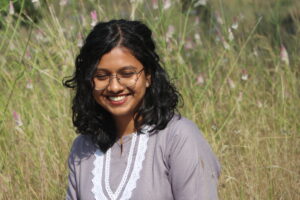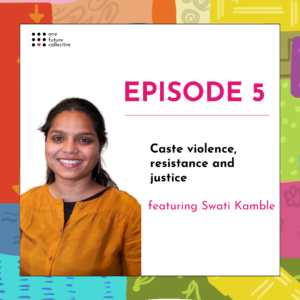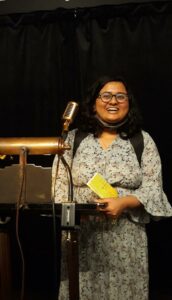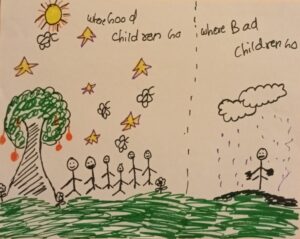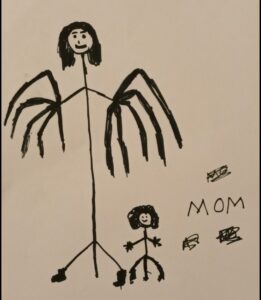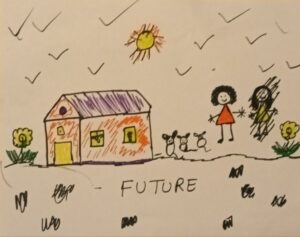Episode 5: Caste violence, resistance and justice
Through the fifth episode of the podcast, we aim to unpack caste violence, its agents and its various manifestations. Our insightful guest, Dr Swati Kamble, also speaks to us about the history of Dalit resistance, the role of women in the movement and also how writing became the medium for seeking justice.
Dr Swati Kamble is an anti-caste intersectional feminist and independent researcher-activist whose research broadly focuses on human rights and social justice movements, decolonisation and intersectionality. Currently, she is researching the digital activism of Dalit women and middle-class Dalit women’s mobility in the Indian neo-liberal market and is also collaborating with Dalit, indigenous and marginalised groups and organisations in India for the mapping and archival of indigenous forms of knowledge and decolonisation.
Content warning: mentions of caste violence and genocide, untouchability, physical abuse, gang rape, rape, sexual assault
Transcript
[Intro]
Abhinaya
Hello everyone, and welcome to the Uncuff India Podcast. I’m Abhinaya and my pronouns are she and her.
Uttanshi- My name is Uttanshi and my pronouns are she and her. We are your hosts for today and it’s lovely to have you all listening in.
[Intro ends]
Uttanshi
In this episode, we aim to understand the processes which inform writing and sharing about violence by the State, particularly by and about people from Dalit communities. We will do this by exploring how the State treats their writing and reporting of state violence, and will critically assess the challenges that the Dalit communities face, including the institutional violence embedded within the process of speaking up.
Abhinaya
And State agencies are modeled on existing, unequal social systems. In practice, this can look like replication and aggravation of existing forms of violence. This becomes possible for the State due to the socio-political, and oftentimes even legal sanctioning of the actions of these agencies. Moreover, given that India’s ranking in the Press Freedom Index has only dipped consistently in the recent past, the silencing and erasure of marginalized narratives is often the outcome. Given these circumstances, through this episode, we aim to understand what’s speaking up against the State and or even speaking out about one’s lived realities mean for people at the intersections of these multiple vulnerabilities.
Uttanshi
Thanks Abhinaya for that. To discuss this and to share their insights on this very important topic with us, we have with us Dr. Swati Kamble. Swati is an anti caste intersectional feminist and independent researcher activist. Her research broadly focuses on human rights and social justice movements, decolonization, and intersectionality. She has a PhD in Socio Economics from the Faculty of Social Sciences at the University of Geneva and her doctoral research focused on the political mobilization of India’s caste affected, caste oppressed communities, their movement history and how this movement has shaped oppressed caste women activists into agents of change. In this research, she studied how Dalit women activists influence policy processes by negotiating and navigating androcentric upper-caste bureaucratic spaces of power. Additionally, she has studied Roma women’s movement in Hungary and how the European Decade for the Roma Inclusion Plan policy did not reflect the issues of Roma women that the Roma civil Society has been advocating for. Currently, she is researching the digital activism of Dalit women and middle class Dalit women’s mobility in the Indian neoliberal market. She is also collaborating with Dalit indigenous and marginalized groups and organizations in India on a project around mapping and archival of indigenous forms of knowledge and decolonization. I am so thrilled to have you join us for this episode, Swati. It’s been phenomenal to be learning from you and to be hearing your thoughts on this very, very important topic. Thank you for being here.
Swati
Thank you so much, Uttanshi. I’m looking forward to this conversation.
Abhinaya
Thank you so much Uttanshi and Swati. I think to start off Swati, I think that there’s a tendency to generally deny that caste violence even exists in our society. So would you be able to shed some light on instances of violence that Dalit communities have experienced in India?
Swati
Yeah, Thank you very much, Abhinaya. Absolutely. There is this tendency due to the constitutional safeguards that exist today- be it on paper most of the times that within India, Dalit communities marginalized communities in general be it also the Adivasi Scheduled Tribes Vimukta and (NT and DNT)-nomadic tribes and denotified tribes communities that who are protected, who have affirmative action, you know, reservation ensured through affirmative action or there is atrocities Prevention of Atrocities Act of 1989 that ensures that you know any form of atrocities against these marginalized communities would be punishable offense. So, and untouchability is constitutionally abolished within India we have these, you know, very very strong legal frameworks that address these injustices, historical injustices meted out against the untouchable communities of yesteryears who are named now Dalits and other vulnerable communities. But our society has not caught up to the constitutional morality that we have. And as we know that the fabric of our society, our Indian society, is a caste fabric, it’s woven in caste. So, all around us we see instances of violence right from institutional violence where students going into higher education or for that matter primary schools, you see that students experience casteism, students are told I mean they’re they are told about their caste while they are asking difficult questions. So, you are always told that you know be grateful for the favor that is done to you by the State. So, State and the society thinks that you are this protected category and are now benefiting from these fruits and you’re not deserving of these fruits. So you have case very, very famous case of Rohit Vemula in 2016 where not only was he a very brilliant scholar, we got to read him only through his suicide note which caused fervor in our our Indian society. And it led to a very strong momentum of student movement within India. A student movement of anti-caste communities, anti-caste students were when he asked difficult questions in the institutions around the Hindutva nationalistic rhetoric that is going around him and other anti-caste students were not allowed to enter the university premises. And when they protested by staying outside the university premises, it’s almost looked at as you know, the very symbolic performance of caste. Where you are ousted, you are ostracized in the similar fashion as written in the scriptures, like you’ll be punished if you have dared to read the Vedas, you will be punished with molten lead in your ears or your tongue would be chopped off. This is what scriptures prescribed, some 2000 odd years ago, 2005, 500 years ago and these archaic rules you see being played out in contemporary times too very very much. Where as a form of protest, Rohit Vemula committed suicide and the anti-caste community’s term it institutional murder. You have this very strong instance where his suicide note talks about his birth being his fatal accident that a human is not acknowledged for his shared humanness. But there will be these labels of caste, of gender, of how much money you have, what is a social cloud that you have, what are your social networks. These are the ways in which humans are graded. And that’s what we see time and again in our Indian society and it’s not only in this direct form of violence that we can not only it’s not only in this direct form of violence where people are murdered, people are killed, but also structurally because you’re not expected to be in these spaces, you’re not allowed to be in this spaces. So when you be there, you be amicable, you be docile, don’t ask questions, follow the norms, norms prescribed by the caste. You don’t do that. You are going above what you’re supposed to do. So this very strong power dynamic conflict arises when subversion takes place within the marginalized, when marginalized ask difficult questions, when marginalized ask truth. Speak truth to the power- the power be it educational institutions, power be it the State, political institutions, judiciary, you get confronted, yet you know Dalit communities have been very, very assertive asking for their rights because there is a 200 years long legacy of movement social movements and that really sort of has emboldened, emancipated a whole lot of Dalit communities. You have other very recent instance of Hathras gang rape in the state of Uttar Pradesh, which is, I dare say, one of the most feudal states in India, most populous state and very divided state in the contemporary Hindu nationalistic State that we are in and you have three years ago, this young woman who was gang raped by the Thakur caste men and her mortal remains were burned by the police. So, police and judiciary worked hand in hand in covering up the entire atrocity that was meted out. Not only that, when the verdict comes out, you see acquittal of the four out of three of the accused and only one of the accused convicted and convicted under the Prevention of Atrocities Act. Despite the dying declaration of the victim who named clearly that she was forcibly sexually violated. So you see that our Indian society is very much steeped in this brahmanical patriarchy where Dalit communities are also taught lesson by controlling women sexually by, you know, doing this. So, Dalit women bear the multiple burden of violence. So you see, educated masses, the critical mass within the community gets the strong bowl blow. The women get the strong blow and these are the ones who are at the forefront of the movement too. So, their assertion on top of the violence that is over, like omnipresent, you see that when they assert, when they dissent and when they ask difficult questions is when they also experience violence. Yes. So these are two instances, but there are multiple of them. In Maharashtra you have Khairlanji that happened in 2006 and I was 20 year old who had just come abroad to study in Sweden. And I remember this very clear, clear as day September of 2006 when we heard of how the entire family was hacked to death, death, how the women of the family were raped, brutally dismembered and the violation is beyond, you know, it’s such a monstrous act. The violation is so extreme that one disbelieves. So I think the majority of society also plays an ostrich. It puts head under the sand and says, oh, look what all we have done. They had only reservation for 10 years. It was meant to be 10 years. It’s been prolonged and it’s been prolonged and it’s been prolonged all the while forgetting that the reservation is not an act to just remedy the, you know, class of poverty. It is an act to reparative justice, you know, all those in historical injustices need to be turned. That’s when we can say that this form of reservation can be ended or when the violence is like not only absence of direct violence, because absence of direct violence can be created by snifling the voices, but you could also, I mean you have to focus on restorative, reparative justice.
Uttanshi
Yeah, no, definitely, Swati. I think there’s so much to unpack in your answer to our question and I think.
Swati
There is, yes, yes, it’s very complex.
Uttanshi
Yeah, definitely. And you know, I’m very intrigued to also step in to just break down some of this complexity a little bit more for our listeners. And I wanted to understand from you, you know, you shared experiences and examples of people from the Dalit community speaking against this form of violence and, yeah, you know, not being silent in the face of this sort of violence. And I wanted to ask. You, you know, what are, what are some of the ways by which we can start thinking about the challenges that a Dalit person faces when they come out and they speak truth to power, right?You of course mentioned some of them, but if you could just highlight, say two or three for our listeners to get that understanding and to be able to really empathize with the challenges that members of the Dalit community may face, it will be really, really fantastic.
Swati
Definitely. So you know I can go back to 2007 and eight when I was a master student and I decided to look at the constitutional guarantees or amendment that’s were made to ensure political participation of women and schedule caste and scheduled tribes. So because and this is also in the background of the 90s where we were really looking at decentralization of government and when we look at decentralization, it looks like ideal panchayat Raj where people have power or to true democracy where, you know, people collectively make decisions about their ways of living in the village. It sounds very sustainable and it sounds very romantic also. But looked at from the caste lens, the villages small, you know, closed knit communities tend to be the dense of, you know, casteism and violence. So, my research was looking at the violence experiences experienced by Dalit communities, specifically Dalit women in the in Maharashtra in beed district- Marathwada region of Maharashtra, which is also within Maharashtra context is one of the very kind of a state region where Dalits have experienced extreme forms of violence also because of the existing movement of existing vibrant Dalit movement there. So, you see side by side the existence of Dalit movement and violence. The Maratwara region experiences the NAMANTAR ANDOLAN server, you would want to look that up. Namantar Server is changing the name of Maratwara University to Dr. Ambedkar University. Now Dr. Ambedkar had contributed tremendously in building educational institutions and, you know, laying out a framework for educational upliftment of marginalized folks. And so, therefore, it was only logical for the state of Maharashtra to lend that honor to him by giving the name of the university and symbolically, it’s not a very huge act, but when the society is casteized, when the society does not acknowledge the revolutionaries and leaders of the communities and when these symbols become, you know, markers of creating histories, taking spaces, acknowledging laying claim to these public spaces, universities, roads and so on, statue building, all these become contested issues. How do they become contested issues? That’s, you know, you rewriting that you were here, you are marking, you’re creating a signpost and then that signpost is not accepted by the dominant society. So, Marathwada region is a very unique region and that’s why I chose to go there to work with a Manavi Haqq ka Abhiyan, which means Human Rights Campaign organization led by late advocate Eknath Awad and there I was looking at how Dalit women are trying to participate in this constitutional amendment of 73rd and 74th Amendment, where you can participate in the Panchayat Raj as a chairperson. You can go for elections and become the chairperson or be the members. Now what was happening in 2006 and seven is that a lot of reports were coming forth. What kind of reports were coming forth of the political participation after a decade, decade and a half of this amendment implementation is that women are merely while women’s participation has increased, they are merely proxies or beti bahu brigade as in beti bahu and wives, daughters, wives and daughter in laws were made proxies to the seat of chairperson. So, the whole business would be taken care by the men of the family and within the Dalit communities it would be the landlord. So, the power dynamic in the villages were playing out and so this was the reporting that was going on in the newspapers and so on. On the other hand, I was also reading civil society organizations, reports, reports of assertion of Dalit communities to exercise the chairmanship and and then the violence meted out to them. So, you had NCDHR bringing out a report called Dalit Women Speak Out and there they mapped out violence against women who were participating in politics. In that research, I looked at 20 women who were participating in politics and, as a young researcher, I saw that you know I went with this feeling that our I went with this knowledge because, you know, you are also studying in educational institutions which are highly colonial, highly upper caste institutions. So you sort of take in what is told to you and I thought that I will have narratives of women experiencing extreme form of violence and I did encountered a lot of, you know, experiences of violence, but what intrigued me further was how these women were in the face of violence still going ahead, claiming their rights. So how did they claim their rights? They were not allowed to sit on the chair. So I wouldn’t be sharing the names of the women. This was already a decade and a half ago, but one of the women that I interviewed, she ensured sitting on the chair by having two police personnel around during the meetings. Another one invited during the flag hoisting of 26th January. She was not allowed to hoist flag for first two years. The third year comes, a whole team of police who stand there and she hoists flag in the presence of police. Now, she tells me these both women told me with amusement, but to have these mere simple symbols of your citizenship as your as being a chairperson being played out you you are sort of having to have police protection. You have someone who went up to Supreme Court because she had a no confidence motion against her because she was asking too many difficult questions during the her chairmanship and she went ahead from High Court to Supreme Court and in the end the President of India felicitated her and she was very proud, but the ordeal that one goes through to sort of claim your simple citizenry rights that should be just ensured to you and it’s it’s quite intrigued me and it sort of turned my attention to look at what are the factors that facilitate the marginalized communities to sustain against all this backlash against all this violence and that’s what my research kind of tried to bring forth. You have many, many famous cases where you know a tribal community person, Mathura Mathura’s case or you look at the Bhavri Devi’s case, you see that these victims of violence, rape then become sort of face of the movement. BhavrI Devi in fact became so very active in her like trajectory after being the survivor of violence. So, these are a few instances from the like your yesteryears, you have the whole strong movement that has come up in recent years against the institutional violence that is taking place, student groups emerging. So, these are the instances where members of the Dalit communities are kind of and writing sort of like intellectually engaging, keeping the discourse going, talking over and over and over again that look around you violence happens because it can be easily forgotten to the point that, you know, Dalit communities are accused that you are crying the same cries all over again and you’re playing a politics of this caste discrimination to forward your own interest. These are the sort of accusations that are slapped at Dalit communities, leaderships and yeah we can even further talk about, you know, other sorts of allegations that the lit women face, Dalit men face, the question of Dalit patriarchy- the term that is introduced by the lip scholar Gopal guru. But how it is used, misused, twisted. How intersectionality is misused and twisted in our future questions.
Abhinaya
Thank you so much for your insights on that question, Swathi, and also for. Also, for depicting what forms Dalit resistance has taken over the years and what it manifests as as well, and since you also specifically mentioned the role of Dalit writing in sustaining and nourishing the Dalit resistance movement, I wanted to understand from you if you could elaborate on that a little bit more and also shed light on the value continuously writing about violence against Dalit, Bahujan and Adivasi folks bring the brings to the table.
Swati
Thank you Abhinaya for that question. Dalit writings in recent years and even in the past years, like you know if you go you’ll have to trace back the history of the one of the first sort of documentation of Dalit writings you you look at Mukta Salve was one of the students of Jyotirao Phule and Savitribai Phule, the first educators of in India of indigenous, you know, background and Mukta Salve writes very critically about the plight of Mahar and Mahan communities in Maharashtra and you see her ask very, very critical, pertinent questions and she talks about the multiple burdens faced by the Dalit women. She talks about intersectionality. I mean, of course, intersectionality came into being just 30 years ago, but the intersectional way of thinking already existed in Dalit writings. So she talks about how Dalit women bear the burden of labor. So, they are laboring classes, but laboring intellectuals. You see that they are, you know, in her writing she talks about how they have to give birth to their babies without a roof and the grueling labor that the men and women continue and that education is going to emancipate them. So, this emphasis on education is already there right from the beginning because she’s the one of the first ones of the community who has received, you know, the benefits of it and has gained her own voice. You come to the 60s and the 70s and you see Dalit writings taking much more revolutionary edge in terms of, you know, the Dalit Panthers movement, which led to literally movement to use literary movement. You look at Namdev Dhasal’s writing, it’s so explosive. One of the poem that touches me to the core is man- you should explode and you you get so uncomfortable by the way he is pouring out this sort of, you know, destruction and towards the end, he says once you are done with all this destructive way of being man, you should become human and that, like you know, is the essence of Dalit writing. I feel Dalit writing invites us to find our humanity. It democratizes our, you know, social fabric which is, you know, very graded. So, you see in the 60s, 70s, 80s, much more Dalit literature coming up, which is it was coming up in such a sort of form that the label was attached to it-Dalit literature. You have Arjun Dangle’s Poisonous Bread, you have the Yapawars Baluto in Maharashtra, you have Urmila Pawar and Urmila Pawar writing. We also wrote Histories, a book where she’s documenting the activism of micro organizations of the little women in the city of Bombay in Maharashtra and she’s trying to unearth and uncover all these unnamed unsung heroines and heroes in her writing. Across India, writing sort of became an exchange within the communities to come together to mobilize. It was sort of a kind of creation of manifestos. What are we experiencing? What are we aspiring to? And it’s so it’s a very radical form of kindness, if I may say so. It’s a radical form of asking critical questions. It’s brave. And I don’t want to romanticize because there are a lot of issues within Dalit and other marginalized communities, but you know, women have been also at the forefront of asking these critical questions through their right things. They have also talked about the way Brahmin Brahmanical patriarchy has affected the Dalit Solidarity or Dalit household. You have Bama’s writing Karukku and you have U-turn by Omprakash Valmiki in the north. So these are very, very interesting books and thoughts produced in them kind of give way forward to Dalit communities. It’s a venting and you know the literature gets sort of accusations that it is descriptive, that it is experiential, that it is anecdotal and that there is no analysis, but if you read through, you see greater philosophical thoughts in those writings. My Mukta Salve is talking about education as emancipation. I mean that’s that’s so profound- like Jyotirao Phule talks about truth seeking society where he’s talking he he invites you to have a critical mind and you know this is way before Pedagogy of Oppressed which invites you critical consciousness came into being and I it’s it’s it’s really for me I feel that it it has made- I mean in in the the the 70s, 80s literature has kind of given a foundation for Dalit communities. And you you see in contemporary times, Dalit women mostly engaging in writings on digital platforms, art, they’re using digital platforms to communicate through their art forms, through their writings, by talking to each other, they’re coming together and internet space, which is also where you know now talking about marginalization, talking about racial discrimination and sort of has kind of garnered some attention- you see Dalit women hypervisiblised in a certain way and Dalit women try to challenge that. They try to challenge the victimization that is their victimization imposed on them. They are they have been victims of the violence, but that is not the only narrative that defines the lit women, Dalit women’s multiple, multiple ways of being are showcased in these forms of writings or communication and knowledge creation and in fact, you know, writing is a contemporary form relatively new to our human society, but before that, there have been indigenous ways, anti-caste ways of being. You know, to the point where I would even say that the dissenting communities of the yesteryears got this and I think I know that Ambedkar writes in his book Whoever Who were the untouchables, Who were the shudras– he’s in fact trying to say that the, you know, when the human divisions happen, those who were defeated or those who were asking who were dissenting were graded lower in the hierarchy. And so it was very important for the caste norms to in fact Ambedkar’s writings are also so very important. It’s no, it’s like, you know, intellectual work and I would also take it as very important literature. And he’s talking about castes in India, their genesis, the mechanisms and so on. Early in the 1930s, already in 1960s, sixteen is his first essay caste in India, then he in 30s, he writes Annihilation of Caste. So, in that 20 years of span he’s already thinking of how these mechanisms have worked to divide our society and how we have sort of ways to annihilate. I we’ll just briefly for a minute talk about someone who is sort of scholar of conflict and peace from Norway- Johan Galtung who, in fact, talked about triangle of violence and this this scholar in fact talks about how a structural violence, cultural violence and the direct violence clubbed together intensifies and creates this whole you know strong wall and I think Dalit writings have been trying to take off brick, brick by brick this structure and in his works around aspiring to peace, Galton also talks about, you know how we should focus on not merely in absence of violence as achievement of peace or achievement of conflict being resolved, but we have sort of have to envision this world of cooperation coexistent Co have like co creating justice. So we need to weave a new fabric of justice, and that’s what, you know, indigenous communities, Dalits have been trying to write.
Uttanshi
Yeah. And I think especially when you are speaking about, you know, how powerful their voices can be, reading about their work can be. It’s really something that makes us reflect a little bit more on, you know what, what kind of literature or what kind of stories are we listening to when we grow up? And what kind of stories are we sharing with the people in ours?
Swati
Precisely. Precisely.
Uttanshi
Yeah. And I think it’s so powerful to listen to you and especially the final thought that you shared with us and our listeners about about, you know, we need to weave a collective understanding of justice and what that means for us and it’s just, you know, the entire time you were speaking Swati, I’m just constantly thinking about. How insightful this conversation has been for both Abhinaya and me, but also I’m sure it will be for all our listeners as well. I also know that there is so much to talk about, but thank you so much, Swati, for the time to do this, for, for talking about this, with this much patience and and and with this much care. It’s really been phenomenal to be listening to you.
Swati
Thank you so much, Uttanshi. I really look forward to this episode and comments of the listeners too.
Uttanshi
Yeah, definitely. Swati, I also want to just take a quick moment to thank our listeners.
[Outro]
Uttanshi-Thank you so much for tuning in today. Please leave us any questions you might have as voice notes on Anchor or in our Dms. We’d love to hear from you and hear your thoughts on this episode. This podcast is brought to you by One Future Collective. Don’t forget to follow us on Instagram and Facebook At the Rate One Future Collective and One Future_India on Twitter. And keep an eye out for future episodes.
[Outro ends]
